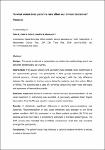To what extent do patients' racial characteristics affect our clinical decisions?
| dc.contributor.author | Plessas, Anastasios | |
| dc.date.accessioned | 2023-08-03T05:27:00Z | |
| dc.date.available | 2023-08-03T05:27:00Z | |
| dc.date.issued | 2019-12-20 | |
| dc.identifier.issn | 1476-5446 | |
| dc.identifier.issn | 1476-5446 | |
| dc.identifier.uri | https://pearl.plymouth.ac.uk/handle/10026.1/21141 | |
| dc.description.abstract |
Design The study employed a randomised controlled trial methodology and it was delivered electronically as a survey. Intervention Fifty-seven primary and secondary care dentists were randomised to two experimental groups. The participants in both groups assessed a vignette (clinical scenario, clinical photograph and radiograph) with the only difference between the vignettes in the two groups being the patient's race (skin colour: Black or White). The scenario was a case of a severely carious first lower molar with signs and symptoms of irreversible pulpitis.Outcome measures The dentists' clinical treatment decisions (recommendation of root canal treatment or extraction) were recorded. A previously validated Brief Implicit Association Test (BIAT) was used to measure implicit racial bias.Results A statistically significant difference in dentists' recommendations was observed. Recommendation of root canal treatment was greater for White patients (86.21%) compared to the Black patients (60.71%) and dentists were far more likely to recommend extraction in the Black patient group. The BIAT scores also indicated that pro-White unconscious racial bias was prevalent amongst the participants. Conclusion A patient's race may influence a dentist's decision whether to extract or retain a decayed tooth. | |
| dc.format.extent | 101-102 | |
| dc.format.medium | ||
| dc.language | en | |
| dc.publisher | Springer Nature [academic journals on nature.com] | |
| dc.subject | Black or African American | |
| dc.subject | Decision Making | |
| dc.subject | Dental Caries | |
| dc.subject | Dentists | |
| dc.subject | Humans | |
| dc.subject | Racism | |
| dc.title | To what extent do patients' racial characteristics affect our clinical decisions? | |
| dc.type | journal-article | |
| dc.type | Journal Article | |
| dc.type | Comment | |
| plymouth.author-url | https://www.ncbi.nlm.nih.gov/pubmed/31863040 | |
| plymouth.issue | 4 | |
| plymouth.volume | 20 | |
| plymouth.publication-status | Published | |
| plymouth.journal | Evidence-Based Dentistry | |
| dc.identifier.doi | 10.1038/s41432-019-0062-1 | |
| plymouth.organisational-group | |Plymouth | |
| plymouth.organisational-group | |Plymouth|Faculty of Health | |
| plymouth.organisational-group | |Plymouth|Users by role | |
| plymouth.organisational-group | |Plymouth|Users by role|Academics | |
| plymouth.organisational-group | |Plymouth|Users by role|Post-Graduate Research Students | |
| plymouth.organisational-group | |Plymouth|Users by role|Researchers in ResearchFish submission | |
| dc.publisher.place | England | |
| dcterms.dateAccepted | 2019-01-01 | |
| dc.date.updated | 2023-08-03T05:27:00Z | |
| dc.rights.embargodate | 2023-8-4 | |
| dc.identifier.eissn | 1476-5446 | |
| dc.rights.embargoperiod | forever | |
| rioxxterms.versionofrecord | 10.1038/s41432-019-0062-1 |


